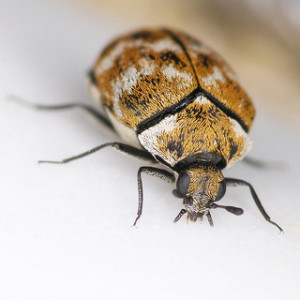Carpet Beetles Often Climb Interior Walls in Spring
By Chris Williams on March 12, 2014.

Adult Carpet Beetle
Tiny Bug Question
We’ve been finding tiny, round bugs in our downstairs family room. They’re about the size of a pin head. They’re mostly in one area and we see just a couple at a time. We find them crawling up the wall and on the windowsill in that corner. I looked at one with a magnifying glass and it’s sort of brownish-white splotchy in color. My wife is worried that these are bed bugs since they’re near where we store our luggage.
Answer
I can tell you that they don’t fit the description of bed bugs, either in appearance or habit. Bed bugs are actually bigger and quite visible, about the size of an apple seed. They’re a solid light brown to reddish brown in color. Most importantly, you don’t see bed bugs wandering around in the daytime, and never at a window.
I can’t give you a positive identification without seeing your bugs in person, but they could be carpet beetles. Early spring is the time of year that we start getting calls about these guys, and they are usually first found crawling up walls.
The larvae of carpet beetles feed on many things, both plant and animal in origin. In homes, I find that they are mostly associated with either a dead mouse or other animal, or with accumulations of hair (mostly pet hair), especially under furniture or in corners and places that are rarely vacuumed. If you add in some miscellaneous lint, dead insects, maybe food crumbs, you can support a small, continuous population of carpet beetle larvae. (Don’t feel badly. Most homes with pets will have a few carpet beetle larvae around somewhere.)
After the tiny, fuzzy larvae are fully developed, they pupate, and turn into adult carpet beetles. The adult beetles are round and calico-colored (brown, white, orange, black). The reason why carpet beetles are a good guess for this time of year is that they have a life cycle closely tied in to the seasons. The adults have very different feeding habits than the larvae. Once the adults emerge in your home, they try to get outside where they feed on the nectar and pollen of flowering plants.
If I were inspecting your home, I would first check the area where you’ve been finding them to see if there is an infested carpet or other woolen item, maybe a nearby pet bed or pet resting area, or even a mounted trophy head. On the other hand, these beetles fly to light so they don’t necessarily have to originate in the same area where you found them. The fact that you are only seeing a few beetles at a time tends to rule out a dead animal as the source.
Give Colonial a call. Our technicians can do a thorough inspection. They’ll identify the pests, evaluate the extent of the infestation, and then set you up with a management program that will solve your problem safely and quickly.
Photo credit: JR Guillaumin / Foter / Creative Commons Attribution-ShareAlike 2.0 Generic (CC BY-SA 2.0)